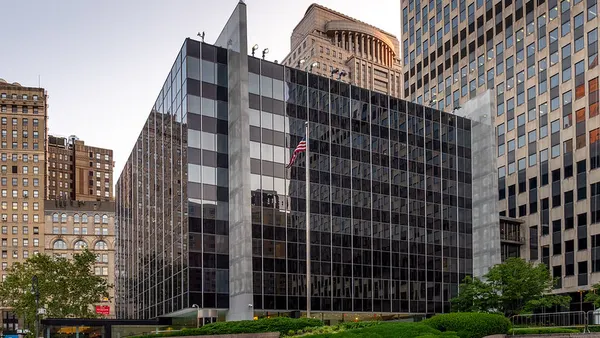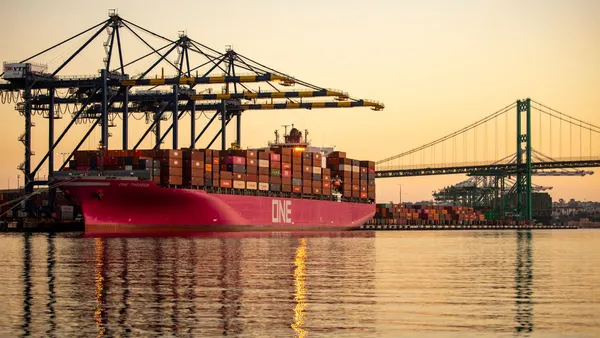Dive Brief:
- Hyundai Merchant Marine (HMM) appears poised for a comeback as recent news of increased investment and post-Hanjin acquisitions better its footing in a competitive shipping industry.
- The line will soon receive an influx of state support to the tune of $632 million from the Korean Shipping Company, Splash 247 reported Wednesday. The Korean Shipping Company will purchase 10 of HMM's boxships to be leased back to the line, as well as 5 new boxships and 3 tankers within the year.
- In addition, HMM seems to have benefited from the collapse of its national rival, Hanjin Shipping. The company announced Thursday it would purchase 100% stake in two more Hanjin terminals, in Tokyo and Kaohsiung, and stated in a separate announcement it had increased Asia-U.S. West Coast (USWC) market share by 2.5% and volume by 45.1% volume since Hanjin's receivership.
Dive Insight:
HMM appears to be quickly digging itself out from under, as less than 3 months ago Maersk, HMM's slot sharer within the 2M Alliance, was forced to reassure clients that only some HMM vessels would be employed to transport shippers' goods, or in other words, they wouldn't get tied into another Hanjin-style fiasco.
But now, HMM is the sixth-largest carrier on the Asia-USWC route after Evergreen, Cosco, Maersk, MSC and APL, and has a market-share of 7.5%, up from 4.9% in Q3 of 2016. Prior to Hanjin's fall (whose market share was 6.7%), the line was not even a top 10 Asia-USWC.
Today's news show just how tied Hanjin and HMM's fortunes are, as HMM now has a stake in four of Hanjin's former terminals (TTI Long Beach, Algeciras, Tokyo and Kaohsiung). Some would say the Korean government picked a winner in the rivalry, by agreeing to restructure HMM earlier and refusing to bail out Hanjin.
The line still seeks to become a top trans-pacific line, although its fortunes amid high competition have made the dream difficult. Nonetheless, the acquisition of two more port terminals in Asia, a consortium with two Korean lines, and slot sharing with the 2M alliance should help bolster its position.
In April, HMM will also establish three Asia-USWC routes, with 19 ships capable of carrying between 6,300-6,800 TEU, up to a weekly maximum of roughly 19,000 TEU. One route will visit Long Beach, another Los Angeles and Oakland, and a third Tacoma and Vancouver. The line is also enjoying an improved credit rating of BB, meaning it is now seen as stable.
The acquisitions and general shake up of assets serve as a prelude to a new era in the shipping industry where only three alliances will dominate the seas beginning April 1. Until then, shipping lines are steadily securing their networks to ensure minimal disruptions when renetworking begins. Shippers, however, are not so sure the process will go smoothly despite the months of preparations — after all, the many intermediaries from ports to freight forwarders will be forced to adjust with somewhat minimal information.













